US Navy says Iran seized and released American sea drone
‘This incident once again demonstrates Iran’s continued destabilizing, illegal and unprofessional activity in the Middle East,’ US general says
Your support helps us to tell the story
From reproductive rights to climate change to Big Tech, The Independent is on the ground when the story is developing. Whether it's investigating the financials of Elon Musk's pro-Trump PAC or producing our latest documentary, 'The A Word', which shines a light on the American women fighting for reproductive rights, we know how important it is to parse out the facts from the messaging.
At such a critical moment in US history, we need reporters on the ground. Your donation allows us to keep sending journalists to speak to both sides of the story.
The Independent is trusted by Americans across the entire political spectrum. And unlike many other quality news outlets, we choose not to lock Americans out of our reporting and analysis with paywalls. We believe quality journalism should be available to everyone, paid for by those who can afford it.
Your support makes all the difference.US officials have said that Iran’s paramilitary Revolutionary Guard attempted to tow away an American sea drone in the Persian Gulf, but released it when approached by a US Navy warship and helicopter.
It was the first time that the drone task force was targeted by the country amid high tensions as negotiations to resurrect the 2015 nuclear deal continue.
The Shahid Baziar warship took hold of the Saildrone Explorer in international waters in the gulf late on Monday, Commander Timothy Hawkins, a spokesperson for the Navy’s fifth fleet, told the Associated Press.
The unmanned sea drone has cameras, radars, and sensors used for monitoring the area from afar.
A coastal patrol boat, the USS Thunderbolt, approached the warship alongside an MH-60 Seahawk helicopter. The Navy contacted the warship to inform them that the drone was American.
“Our response was one that as such made clear that this was US government property and was operating in international waters and that we had every intention to take action if necessary,” Commander Hawkins told the AP.
The spokesperson said the situation came to a peaceful end after four hours. The Iranian forces detached the drone from the warship and left the drone behind, with US forces in the vicinity.


The Navy released video footage showing the Iranian ship pulling along the drone as the USS Thunderbolt followed.
Central Command leader, US Army General Michael Kurilla said in a statement that “this incident once again demonstrates Iran’s continued destabilizing, illegal and unprofessional activity in the Middle East”.
The Iranian Tasnim news agency, which is thought to be affiliated with the Revolutionary Guard, claimed on Wednesday without providing evidence that the drone had been putting international shipping at risk.
While the news agency said the Guard released the drone, it also said the US version of events was “a Hollywood narrative and contrary to the truth”.
Task Force 59, which is unmanned, was launched by the fifth fleet last year. The fifth fleet covers an area that includes the Strait of Hormuz, which leads into the Persian Gulf on the southern coast of Iran.
A fifth of all oil passes through the strait. The area of responsibility for the fifth fleet goes all the way to the Red Sea, almost to the Suez Canal, which connects the Middle East to the Mediterranean, as well as the Bab el-Mandeb Strait near Yemen, the AP noted.
The region has seen a number of attacks at sea in the last few years, with drone boats filled with bombs, as well as mines, having been sent out by the Houthi rebels in Yemen.
Oil tankers have been seized by Iranian forces close to the Strait of Hormuz and the United Arab Emirates. There have also been attacks on tankers, which the US Navy has blamed Iran for. The attacks came about a year after then-President Donald Trump left the Iran nuclear deal in 2018.
The deal had sanctions lifted on the country as it restricted its uranium enrichment.
Iran is now closer than it ever has been to weapons-grade levels of uranium enrichment and some officials publically suggest that they could build a nuclear bomb if a decision was made to do so.
Iran claims that the programme is peaceful, but countries in the West and international inspectors said the country had a military nuclear programme until 2003, the AP reported.




Join our commenting forum
Join thought-provoking conversations, follow other Independent readers and see their replies
Comments